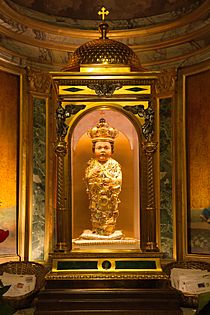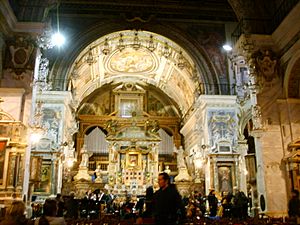Santo Bambino of Aracoeli facts for kids
Quick facts for kids Santo Bambino di AracœliHoly Child of Aracœli |
|
|---|---|

The image enshrined within the Basilica.
|
|
| Location | Capitoline Hill |
| Date | 15th century |
| Witness | Franciscan friar Prince Alessandro Torlonia |
| Type | Olive wood |
| Approval | Pope Leo XIII Pope John Paul II |
| Shrine | Basilica of Santa Maria in Aracoeli |
The Santo Bambino of Aracœli (which means "Holy Child of Aracœli") is a special wooden statue from the 1400s. It shows the Child Jesus wrapped in golden cloth, wearing a crown. People have given it many beautiful jewels over the years. This statue is kept in the Basilica of Santa Maria in Aracoeli in Rome.
Important leaders of the Catholic Church have recognized this statue. Pope Leo XIII allowed people to pray to it publicly in 1894. He also gave it a special blessing in 1897. Later, Pope John Paul II blessed it again in 1984. The original statue was stolen in 1994, so now a new copy is in its place.
Contents
History of the Holy Child Statue
The wooden statue is about 60 centimeters (2 feet) tall. It shows Jesus as a baby. Records from the Basilica Santa Maria in Aracoeli say that a Franciscan friar carved the statue. He made it from a single piece of olive wood. This wood came from the Garden of Gethsemane in the Holy Land during the 1400s.
People started making special trips to see the statue as early as 1794. In 1798, French soldiers took the statue. But a rich Roman, Serafin Petraca, paid money to get it back. This saved it from being burned. The statue stayed in a convent for about a year while a new special place was built for it.
In 1838, thieves pretended to kiss the statue. Instead, they stole many of the jewels that decorated it. During protests against the Catholic Church in 1848, a man named Carlo Armellini saved the Santo Bambino from being set on fire.
Special Traditions and Beliefs
Romans have long believed the statue could help heal sick people. One story from the 1800s tells of a very sick person from the noble Torlonia family. The friars were asked to bring the Santo Bambino to the sickbed. They did, and the person got better.
After that, Prince Alessandro Torlonia used a special carriage. This carriage once belonged to Pope Leo XIII. Every Thursday, he would take the statue to visit sick people who could not go to the Basilica. This tradition continued until the early 1900s.
Another statue like the Santo Bambino is in the Church of San Giovanni in Cori, Lazio. It is called the Bambinello. Some people believe this statue in Cori might be the original one from the 1400s. They think it was moved there in the 1700s to protect it from being stolen. If this is true, then the statue stolen from Aracoeli in 1994 was actually an older copy.
A special sun-shaped pin, called a brooch, was once on the statue. It was called the Sun of Justice. This pin was later stolen. Old pictures from the 1800s show the statue wearing this sun brooch.
In 1927, a British diplomat in Rome became very ill. Someone suggested sending for the Bambino. A man named Philip Langdon went to Santa Maria in Aracoeli. On his way back, soldiers stopped him and the friar. The street was blocked because a leader was giving a speech. Even though their car had a cardinal's symbol, they were not allowed to pass. But when Langdon said he was bringing the Bambino to a dying man, the soldiers let them through.
Today, the chapel at Aracoeli is full of letters. These letters come from all over the world. Some are simply addressed to "Il Bambino, Rome." To make space, old letters are removed every few weeks. They are burned with incense. The letters are not opened. A Franciscan who cares for the statue says, "What is in the letters is a matter between the Bambino and the letter writer."
During Christmas, the Bambino statue is usually placed in the crèche at the Basilica. Another old custom was for children aged six to ten to stand on a platform. From there, they would speak to the Bambino. This tradition is not common anymore. It has been replaced by larger religious parades.
Official Church Recognition
- On January 18, 1894, Pope Leo XIII officially allowed people to pray to the statue. He also wrote a special prayer for the baby Jesus.
- On May 2, 1897, Pope Leo XIII gave the statue a special blessing called a canonical coronation. This was done through the Vatican Chapter.
- The statue was also mentioned in a letter from Pope Paul VI in 1969. This letter was for the World Day of Peace.
- On January 8, 1984, Pope John Paul II blessed the statue again. He did this during a special event for children.
The Statue is Stolen
The original statue was decorated with many valuable gifts called ex-votos. These were offerings from people who believed the statue had helped them. The statue was usually kept in a locked cabinet at night. But on February 1, 1994, around 4:00 PM, two thieves dressed as construction workers. They were working on a scaffold at the monastery.
One story says the thieves searched the friars' rooms for valuables. They found the armored cabinet where the statue was kept open. Another story says the statue was still on display in the Basilica's crèche. It was supposed to be moved the next day.
The police thought it would be hard to get back the gold and jewels. But they also believed the Santo Bambino was too famous to be sold easily. The theft made many people in Rome very angry. Some rich people offered to pay money to get the statue back. However, the Franciscans did not want this. Instead, they decided to have a new copy made. Even the prisoners at the Regina Coeli prison wrote a letter. They asked the thieves to return the statue. When that did not work, they donated money for the new copy.
Legends of the Holy Child
There are some interesting stories about the Santo Bambino. One story says that the friar who carved the statue did not have all the paints he needed. An angel then finished the painting for him. When the friar was sailing back to Italy, his ship was caught in a storm. The ship was wrecked. But the friar survived. Later, he found the statue washed up on the shore in Livorno.
Another tale is from 1797. The Princess Paolina Borghese wanted the statue for herself. So, she had a copy made. When her cousin became very sick, the family asked for the Bambino to be brought. But the princess sent the copy instead. However, at midnight, the bells at Santa Maria in Aracoeli rang. The statue miraculously returned to its rightful place. This story inspired a famous urban legend about a noblewoman pretending to be sick to take the statue home.
A tradition says that the lips of the Holy Child statue change color. They turn red when a wish is going to come true. They turn white when a request is not likely to be granted.
See also
- Infant Jesus of Prague
- Infant Jesus of Mechelen
- Santo Niño de Cebu
- Christ Child
- List of canonically crowned images
- List of statues of Jesus


